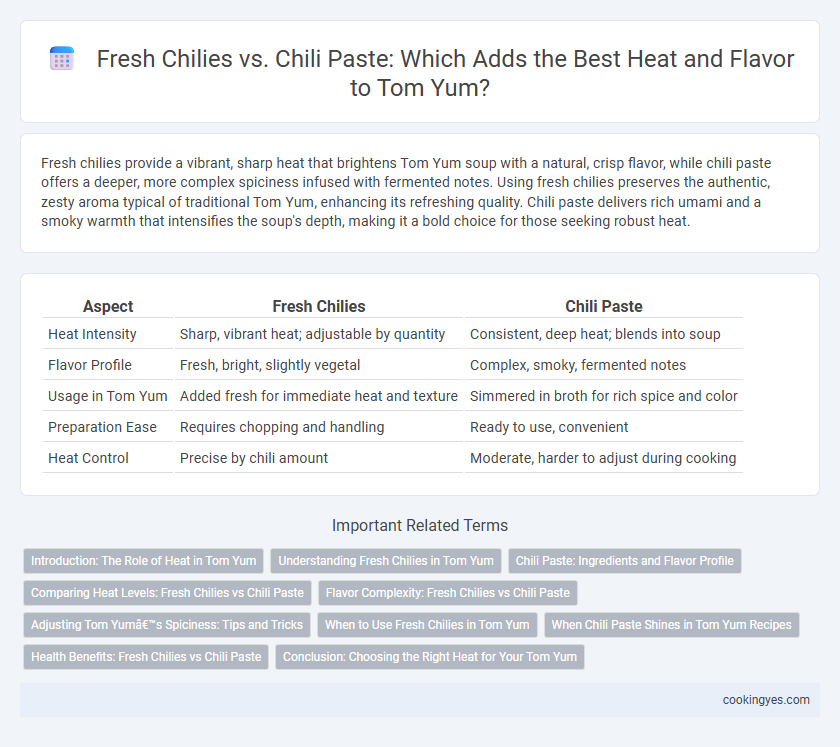Fresh chilies provide a vibrant, sharp heat that brightens Tom Yum soup with a natural, crisp flavor, while chili paste offers a deeper, more complex spiciness infused with fermented notes. Using fresh chilies preserves the authentic, zesty aroma typical of traditional Tom Yum, enhancing its refreshing quality. Chili paste delivers rich umami and a smoky warmth that intensifies the soup's depth, making it a bold choice for those seeking robust heat.
Table of Comparison
| Aspect | Fresh Chilies | Chili Paste |
|---|---|---|
| Heat Intensity | Sharp, vibrant heat; adjustable by quantity | Consistent, deep heat; blends into soup |
| Flavor Profile | Fresh, bright, slightly vegetal | Complex, smoky, fermented notes |
| Usage in Tom Yum | Added fresh for immediate heat and texture | Simmered in broth for rich spice and color |
| Preparation Ease | Requires chopping and handling | Ready to use, convenient |
| Heat Control | Precise by chili amount | Moderate, harder to adjust during cooking |
Introduction: The Role of Heat in Tom Yum
Fresh chilies provide vibrant, sharp heat to Tom Yum, intensifying its signature spicy profile with natural oils and crisp bite. Chili paste introduces a deeper, more complex heat, blending fermented flavors that enrich the soup's umami and smoky undertones. Balancing fresh chilies and chili paste ensures authentic, layered heat essential to Tom Yum's dynamic taste experience.
Understanding Fresh Chilies in Tom Yum
Fresh chilies bring a vibrant, sharp heat to Tom Yum, enhancing its signature tangy and aromatic profile with crisp, green notes that chili paste often lacks. Their natural oils and fresh capsaicin content provide a more immediate and clean spiciness, allowing for better control over the soup's heat intensity. Using fresh chilies also preserves the authentic, bright flavors crucial to traditional Tom Yum recipes, offering a balance between heat and freshness that chili paste, with its fermented base, can overpower.
Chili Paste: Ingredients and Flavor Profile
Chili paste in Tom Yum typically combines dried red chilies, garlic, shallots, lemongrass, and shrimp paste, creating a rich and complex flavor profile that balances heat with umami and aromatic notes. Unlike fresh chilies, the paste offers a deep, smoky spiciness and enhances the soup's savory depth, contributing to the signature bold taste of authentic Tom Yum. The fermentation and roasting process in chili paste intensifies its pungency while blending seamlessly with the soup's sour and herbal ingredients.
Comparing Heat Levels: Fresh Chilies vs Chili Paste
Fresh chilies provide a sharper, more immediate heat with vibrant fruity undertones, while chili paste offers a deeper, more complex spiciness due to the fermentation process. Heat levels in fresh chilies vary depending on the type used, such as bird's eye chilies known for their intense punch, whereas chili paste heat is consistent and balanced by added ingredients like garlic and shrimp paste. Using fresh chilies intensifies the bright, aromatic heat of Tom Yum, whereas chili paste enriches the broth with layered, lingering warmth.
Flavor Complexity: Fresh Chilies vs Chili Paste
Fresh chilies bring vibrant, crisp heat with a clean, sharp bite that enhances Tom Yum's bright, herbal notes, while chili paste offers a richer, deeper heat infused with additional flavors from fermented ingredients and spices. The complexity of chili paste adds layers of umami and subtle sweetness, creating a more rounded and intense flavor profile. Choosing fresh chilies emphasizes freshness and a lively spiciness, whereas chili paste contributes a bold, savory depth essential for traditional Tom Yum recipes.
Adjusting Tom Yum’s Spiciness: Tips and Tricks
Fresh chilies provide a vibrant, sharp heat and a crisp texture to Tom Yum, allowing precise control over spiciness by adjusting the quantity and type of chili used. Chili paste offers a more concentrated, smoky heat with added depth from fermented ingredients, making it ideal for consistent spice levels and richer flavor complexity. Combining both fresh chilies and chili paste enables home cooks to fine-tune the heat intensity while enhancing the authentic taste profile of traditional Tom Yum soup.
When to Use Fresh Chilies in Tom Yum
Fresh chilies are ideal for Tom Yum when a vibrant, crisp heat is desired, as they provide a sharp, natural spiciness that enhances the broth's brightness. Use fresh chilies during the initial stages of cooking to infuse the soup with a clean, invigorating heat without overpowering the other flavors. This approach is perfect for those seeking a crisp, lively spiciness in authentic Thai Tom Yum.
When Chili Paste Shines in Tom Yum Recipes
Chili paste brings a deep, rich heat to Tom Yum that fresh chilies alone cannot achieve, thanks to its blend of roasted spices and fermented ingredients. The paste's complex flavor profile enhances the broth's savory notes, balancing the sourness of lime and the sweetness of coconut milk for a more layered taste. When slow-simmered in the soup, chili paste infuses every element with robust spiciness and umami, making it indispensable in authentic Tom Yum recipes.
Health Benefits: Fresh Chilies vs Chili Paste
Fresh chilies in Tom Yum provide higher levels of vitamin C and antioxidants, which support immune function and reduce inflammation. Chili paste often contains added ingredients like sugar and preservatives, which may diminish its overall health benefits compared to fresh chilies. The capsaicin in fresh chilies promotes metabolism and pain relief more effectively due to its unprocessed form.
Conclusion: Choosing the Right Heat for Your Tom Yum
Fresh chilies deliver a vibrant, sharp heat that intensifies the authentic Thai flavor in Tom Yum, while chili paste offers a richer, more balanced spiciness infused with savory undertones. Selecting fresh chilies allows for precise control over the heat intensity, ideal for those seeking a crisp, fiery kick. Opting for chili paste creates a deeper, more complex heat that blends seamlessly with the soup's other ingredients, perfect for a harmonious taste profile.
Fresh Chilies vs Chili Paste for Tom Yum heat Infographic

 cookingyes.com
cookingyes.com